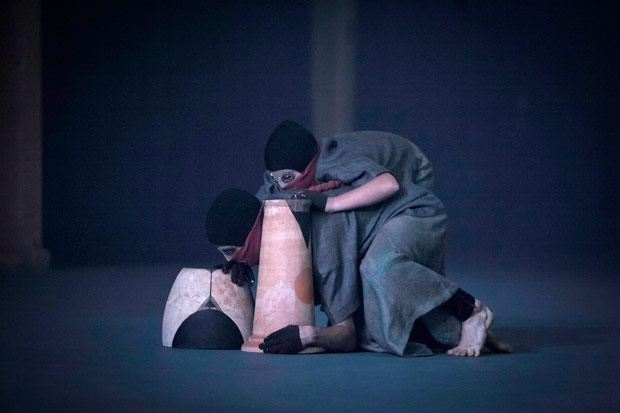
© Byron Perry. (Click image for larger version)
Antony Hamilton Projects
Melbourne Festival: NYX
Melbourne, Meat Market
8 October 2015
antonyhamiltonprojects.com
www.festival.melbourne
NYX, choreographed by Melbourne-based contemporary choreographer Antony Hamilton, was one of the few new Australian dance works (and the only premiere by a local dance artist) in this year’s Melbourne Festival. This work has been highly anticipated by contemporary dance fans – Hamilton is a well-known artist who has made a successful transition from student to professional dancer to emerging choreographer and now, finally, to established artist. It has been a long time coming, and Hamilton’s well-deserved rise to prominence has been further buoyed by an international tour of his work in Europe. NYX is Hamilton’s most recent work, immediately preceded by Meeting, a collaborative work with fellow dancer/choreographer and robotic programmer, Alisdair Macindoe, that premiered earlier this year as part of Dance Massive.
NYX is inspired by the classical goddess of night: in mythology, Nyx is an ancient deity from Gaius’ generation of archaic gods and goddesses, an omnipresent but shadowy figure. Daughter of Chaos and mother to Death, Sleep, and Charon (the guide for the dead), her power is as much tied up in her femininity and fertility as in her own elusive presence. Hamilton’s NYX certainly draws on the spectacle of archaic, or pagan worship and expressions of the sacred, even as it presents a kind of interpretation of feminine mystery. This latter element is explored in a number of ways, but primarily through the representation of four female dancers (Lily Paskas, Rachel Coulson, Lauren Langlois, Kathleen Lott) as otherworldly creatures dressed in black. All four have long, flowing hair – worn down and loose – that creates a shroud around their faces, only to fly away with a sharp movement and offer us a momentary glimpse of eyes and noses and mouths. Although NYX could be seen as a story of female power from a certain angle, there remains something androgynous about the way these four dancers are presented and the way they move through space.
Metaphors for worship also come with the arrival of eight faceless acolytes. These roles are performed by undergraduate dance students from the Victorian College of the Arts, who developed the sequence for a work Hamilton created for their student concert two years ago. The acolytes perform a strong unison section in which they sit cross-legged and hold various percussive objects in a tightly-structured sequence of gestures. These gestures are repeated and then shifted, so the sense is of a ripple of movement and sound in the near-darkness of the theatrical space. This particular section of choreography was easily recognizable from a work that Hamilton set on VCA students for the undergraduate dance performance, Pattern Study 1, several years ago.
The acolytes are essentially a supporting chorus, perhaps an evocation of Greek tragedy, but without necessarily providing the audience with specific messages. Instead, these anonymous, homogenous creatures serve as worshippers and even servants to their goddess – another ‘other’ in this strange and unfriendly world. They wear shapeless grey dresses and red scarves that obscure most of their faces; they move in a jogging phalanx around the stage and are completely indistinguishable from one another. The spaces around their eyes, just visible above the red scarves, are covered in dark glitter, an effect that draws the eye of the audience even as it further dehumanises the performers.
Throughout the work, the four women and their acolytes create and destruct ‘shrines’, which consist of piles of small treasures in the form of beads, marbles, shiny silver and rusty copper bowls, chunks of metal, shards of pottery and large ceramic urns with black painted markings. It feels like a fait accompli from the very beginning of the piece that these mini monuments will be built and then somehow deconstructed in some way. Once they have been destroyed the first time, the dancers set about creating new forms of organisation, and at the end, even build a monument around the prone body of one dancer by shunting objects across the stage until they cluster around her limbs. However, the physical action of deconstruction is about more than just the outcome of new creation: with the manipulation of physical objects comes the sense that each piece of metal, each bead and marble is itself important and necessary, even while still a cog in a larger machine.

© Byron Perry. (Click image for larger version)
NYX begins with careful and organised constructs of these objects, ordered by shape and size in neat piles around the stage. In some way, their placement is reminiscent of site-specific land art, in which part of the artistic lifecycle is the gradual washing away through natural elements. However, NYX doesn’t present a natural world, anymore than Hamilton’s previous works that presented objects as icons, such as in Keep Everything and his Black Project series. Instead, this is a story of external factors that divide the darkness into smaller segments. This notion of division or segmentation is further emphasised in Hamilton’s detailed choreographic structures and tight unison sequences. Benjamin Cistern’s lighting design heightens this visual sensation of divisions near and far, shifting from complete darkness to ambient glows to streams of light that cut through the massive performance space.
As the piece begins, we can just make out four figures standing in a line in the distance gloom of the space. They are little more than blurs of flesh that move as though underwater. Are these four separate manifestations of Nyx, our archaic goddess? Or are they, perhaps, merely a kind of shared consciousness? The four women begin generating sound, gently singing and humming as if outlining a ritual invocation. As the pitch modulates, the dancers break from the waist, pitching forwards and backwards with increasing violence. Soothing humming fragments devolve into gestures of frustration. Once goddesses, now angry fishwives, the women curse at the sky and one another in a language we can’t understand. The dancers drop to the ground to manipulate the small pieces of metal on the floor, gradually shifting them downstage towards the audience. The movement patterns are precise and detailed – they push one bit forward and draw another on backwards, all while tapping the ground to build a layered rhythm, which both accompanies and derives from their movement. The scratching, sliding and tapping of objects on the ground or the collision of one against another combines with the heavy whoosh of human breathing, panting and vocalisations to form the basis for NYX’s soundscore.
In NYX, it is as if every sonic possibility for the metal and ceramic objects is wrung out of the material placed on stage. The bodies, and the objects that surround them, meld into a complex motion orchestra. Along with vocalisations and unison breathing patterns, the objects form the essential rhythmic environment for this work. All of the sound is generated on stage, with everything from the scrape of ceramic shard against the floor to the scattering of beads, layered and exploited. The use of movement as a generator for sound design is recognisably ‘Hamilton-esque’ – previously, I have referred to a ‘rhythmic imperative’ as a crucial element for understanding his work.
Hamilton has developed his particular use of voice, text and sound generation across an array of previous works, both as a dancer and choreographer. Some examples include his performances in Lucy Guerin Inc’s Corridor and Aether, in Two-faced Bastard, (created by Guerin and Chunky Move’s Gideon Obarzanek), and in his own previous works, I Like This, Black Project I, and Keep Everything. Keep Everything, in particular, shares many similarities with this new work: in that work, the dancers (Alisdair Macindoe, Lauren Langlois and Benjamin Hancock) toyed with a world of ‘garbage’, using paper, plastic and other objects as a way to provide commentary on human evolution, but also as tools to inspire improvisational development through the work and instruments for sound. Where Keep Everything sought to find humour in absurdity, to celebrate the notion of human-as-database via a strong social commentary, NYX is much more abstract and feels fundamentally more serious.
Ultimately, the discipline demanded by Hamilton’s works of this style through both unison and vocal control, is spectacular. The rhythm is king, and the patterns are the imperative. But perhaps most importantly, the sense that movement is meant to be heard as well as seen, and that the body should be a multi-useful tool for sonic, gestural and rhythmic possibilities: this is a space that Hamilton is trying to claim.
As a choreographer, Hamilton also excels at details. Watching his work is rather like admiring a tapestry being created before our eyes. Rhythms, gestures and sequences of tight unison are woven together into incredibly specific and particular forms. It is a work that wants to be seen in terms of a microcosm, in terms of each tiny stitch that somehow makes up a larger design. However, the way in which the overall development of the work unfolds is less focused and perhaps, less important. But this is also where the dissatisfaction lies. If we expand the metaphor of a tapestry, it is almost as though all the attention is given to each stitch, but one struggles to stand back and see the larger picture. And so despite Hamilton’s absolute excellence at structuring on a micro level, NYX demonstrates that the outside eye – the macro view – is missing.
Despite some outstanding moments, NYX doesn’t feel like a work that pushes Hamilton forward as a choreographer. It feels like familiar and known territory that is safe for him, safe for us and, despite the demands on the dancers to memorize and execute such intricate rhythmic and physical patterns, safe for them as well. Hamilton’s challenge moving forward will be in demonstrating what more he can do.









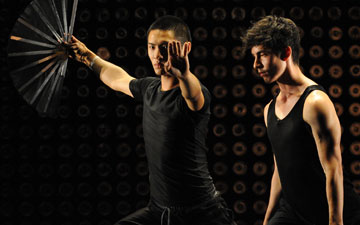
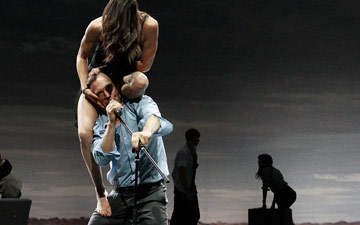


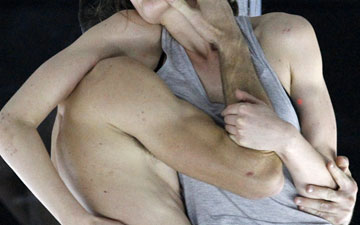

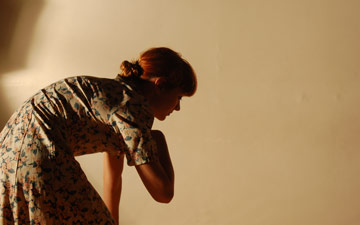
You must be logged in to post a comment.